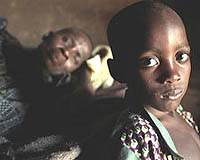



| Skrikwekkende aanslag van tuberculose en vigs in Afrika Deadly HIV-TB co-epidemic sweeps sub-Saharan Africa: report
Paris (AFP) Nov 2, 2007 Drug-resistant tuberculosis and HIV have merged into a double-barreled epidemic that is sweeping across sub-Saharan Africa and threatening global efforts to eradicate both diseases, according to a report released Friday. Over-burdened health systems are unable to cope with the epidemic and risk collapse, said the report, which calls for urgent measures to curb its spread. A third of the world's 40 million HIV/AIDS sufferers also have TB, and the death rate for people infected with both is five times higher than that for tuberculosis alone. The situation is aggravated by surging rates of multi-drug resistant (MDR) and extensively drug-resistant (XDR) TB precisely in those areas where the rates of HIV infection are highest. MDR and XDR tuberculosis are resistant to some or all of the standard drugs used to fight the disease. "Now the eye of the storm is in sub-Saharan Africa, where half of new TB cases are HIV co-infected," said Veronica Miller, co-author of the report and director of The Forum for Collaborative HIV Research, which issued the study. "Unlike bird flu, the global threat of HIV/TB is not hypothetical -- it is here now," she said. One third of the world's population carries the tuberculosis bacterium, but the disease remains latent in nine out of 10. HIV, however, changes the equation: Of those whose immune systems have been compromised by HIV, 10 percent will develop active tuberculosis each year, according to the report. "In today's world, a new TB infection occurs every second. When one considers that much of this transmission occurs in areas with high HIV prevalence, the imminent danger of a global co-epidemic is clear," said Diane Havlir, head of the World Health Organisation's TB/HIV working group. TB control has been severely destabilised in regions with high rates of HIV, the study says. In one community of 13,000 people outside of Cape Town, South Africa, the TB patient case load increased six-fold between 1996 and 2004, the researchers reported. "There has been a staggering increase in TB in this community, and this has been replicated right across southern Africa," Stephan Lawn, a medical researcher at the University of Cape Town, said in a statement. The report called for urgent coordinated action on the part of governments, researchers, drug companies and local communities. The measures called for include fast diagnostic tests to detect all forms of TB in HIV-infected adults and children; new methods to rapidly map HIV and TB hotspots; new screening tools to identify new cases of drug-resistant TB; and better equipment for field laboratories in the most affected areas. There are approximately nine million new cases of tuberculosis in the world every year, according to the WHO. In 2005, the disease killed 1.6 million people. At the same time, an estimated 40 million people are living with HIV, according to the UN and the WHO. There were 4.3 million new infections in 2006 with 2.8 million (65 percent) of these occurring in sub-Saharan Africa. In 2006, 2.9 million people died of AIDS-related illnesses. In South Africa, HIV/AIDS is the leading cause of child mortality and accounts for 40 to 60 percent of all deaths nationwide, according to UNICEF. 
[terug] |


